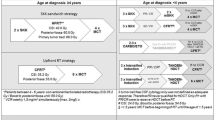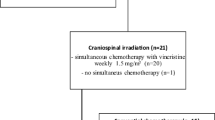Abstract
Background: The prognosis for children with M1 medulloblastoma (positive CSF cytology) has not been well-defined. Methods: We retrospectively reviewed the records of 285 newly diagnosed medulloblastoma patients treated between 1984 and 2006. Older children received post-operative craniospinal and tumor bed irradiation; radiotherapy for younger children depended on treatment era and physician/family preference. Results: 55 patients were <3 years old and 230 patients were ≥ 3 years old at diagnosis. We detected significant (P < 0.0001) associations between M1 disease and EFS for the entire cohort and for both younger and older patients. Among younger children, M1 patients had lower EFS than M0 (P = 0.0044). Conclusions: Children <3 years old with M1 medulloblastoma fared poorly in our small series. Survival for older children with M1 disease treated with higher-dose CSI was better than that of M2/M3 patients, but still less than optimal; our findings do not support reduction in therapy for either cohort.

Similar content being viewed by others
References
Zeltzer PM, Boyett JM, Finlay JL et al (1999) Metastasis stage, adjuvant treatment, and residual tumor are prognostic factors for medulloblastoma in children: conclusions from the Children’s Cancer Group 921 randomized phase III study. J Clin Oncol 17:832–845
Duffner PK, Horowitz ME, Krischer JP et al (1999) The treatment of malignant brain tumors in infants and very young children: an update of the Pediatric Oncology Group experience. Neuro Oncol 1:152–161. doi:10.1215/15228517-1-2-152
Geyer JR, Sposto R, Jennings M et al (2005) Multiagent chemotherapy and deferred radiotherapy in infants with malignant brain tumors: a report from the Children’s Cancer Group. J Clin Oncol 23:7621–7631. doi:10.1200/JCO.2005.09.095
Rutkowski S, Bode U, Deinlein F et al (2005) Treatment of early childhood medulloblastoma by post-operative chemotherapy alone. N Engl J Med 352:978–986. doi:10.1056/NEJMoa042176
Grill J, Sainte-Rose C, Jouvet A et al (2005) Treatment of medulloblastoma with post-operative chemotherapy alone: an SFOP prospective trial in young children. Lancet Oncol 6:573–580. doi:10.1016/S1470-2045(05)70252-7
Chi SN, Gardner SL, Levy AS et al (2004) Feasibility and response to induction chemotherapy intensified with high-dose methotrexate for young children with newly diagnosed high risk disseminated medulloblastoma. J Clin Oncol 22:4881–4887. doi:10.1200/JCO.2004.12.126
Gajjar A, Chintagumpala M, Ashley D et al (2006) Risk-adapted craniospinal radiotherapy followed by high-dose chemotherapy and stem-cell rescue in children with newly diagnosed medulloblastoma (St Jude Medulloblastoma-96): long-term results from a prospective, multicentre trial. Lancet Oncol 7:813–820. doi:10.1016/S1470-2045(06)70867-1
Kortmann RD, Kuhl J, Timmermann B et al (2000) Post-operative neoadjuvant chemotherapy before radiotherapy as compared to immediate radiotherapy followed by maintenance chemotherapy in the treatment of medulloblastoma in childhood: results of the German prospective randomized trial HIT ‘91. Int J Radiat Oncol Biol Phys 46:269–279. doi:10.1016/S0360-3016(99)00369-7
Duffner PK, Horowitz ME, Krischer JP et al (1993) Post-operative chemotherapy and delayed radiation in children less than three years of age with malignant brain tumors. N Engl J Med 328:1725–1731. doi:10.1056/NEJM199306173282401
Kalbfleisch JD, Prentice RL (1980) The statistical analysis of failure time data. Wiley, New York
Razzouk BI, Heideman RL, Friedman HS et al (1995) A phase II evaluation of thiotepa followed by other multiagent chemotherapy regimens in infants and young children with malignant brain tumors. Cancer 75:2762–2767. doi 10.1002/1097-0142(19950601)75:11<;2762::AID-CNCR2820751121>;3.0.CO;2-2
Blaney SM, Boyett J, Friedman HS et al (2005) Phase I clinical trial of mafosfamide in infants and children aged three years or younger with newly diagnosed embryonal tumors: a pediatric brain tumor consortium study (PBTC-001). J Clin Oncol 23:525–531. doi:10.1200/JCO.2005.06.544
Geyer JR, Zeltzer PM, Boyett JM et al (1994) Survival of infants with primitive neuroectodermal tumors or malignant ependymomas of the CNS treated with eight drugs in one day: a report from the Children’s Cancer Group. J Clin Oncol 12:1607–1615
Acknowledgments
This work was supported by a Cancer Center (CORE) Support Grant (CA 21765) from the National Institutes of Health, Musicians against Childhood Cancer (MACC), the Noyes Foundation, the Ryan McGhee Foundation, Anderson Foundation and the American Lebanese Syrian Associated Charities (ALSAC).
Author information
Authors and Affiliations
Corresponding author
Rights and permissions
About this article
Cite this article
Sanders, R.P., Onar, A., Boyett, J.M. et al. M1 Medulloblastoma: high risk at any age. J Neurooncol 90, 351–355 (2008). https://doi.org/10.1007/s11060-008-9671-9
Received:
Accepted:
Published:
Issue Date:
DOI: https://doi.org/10.1007/s11060-008-9671-9




